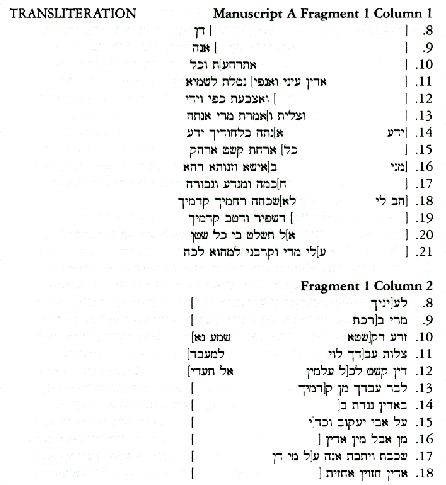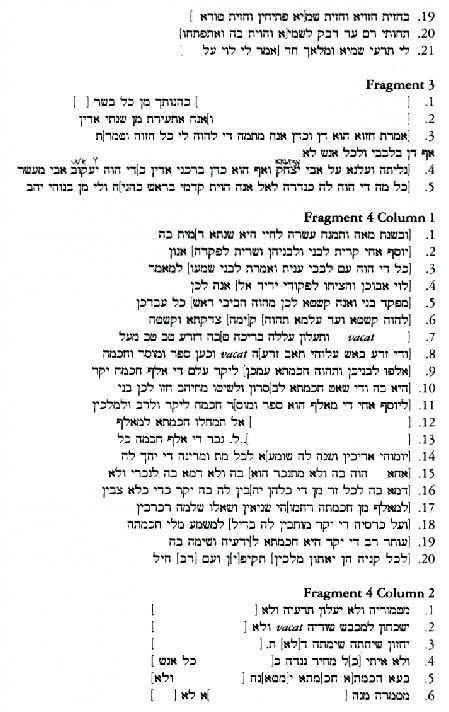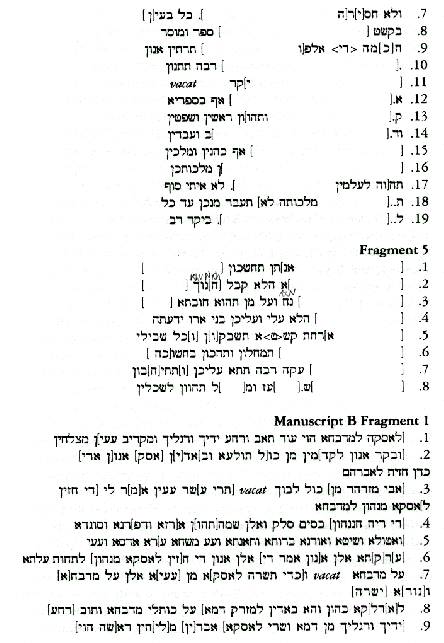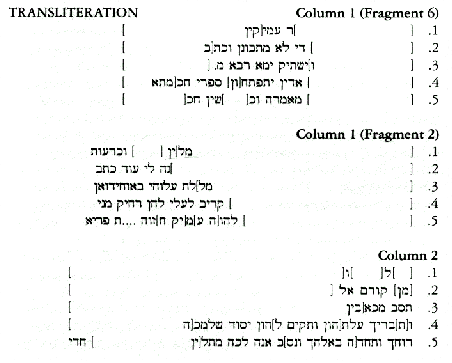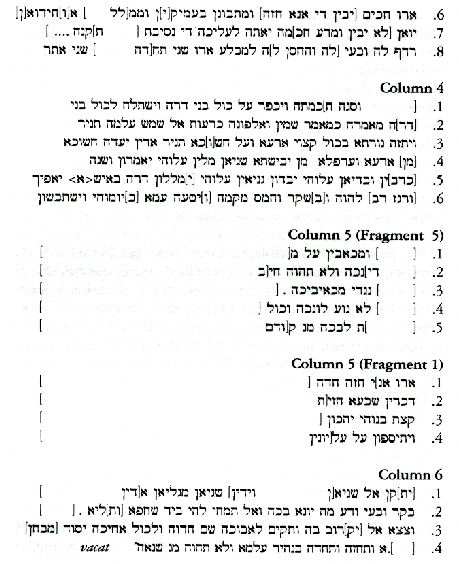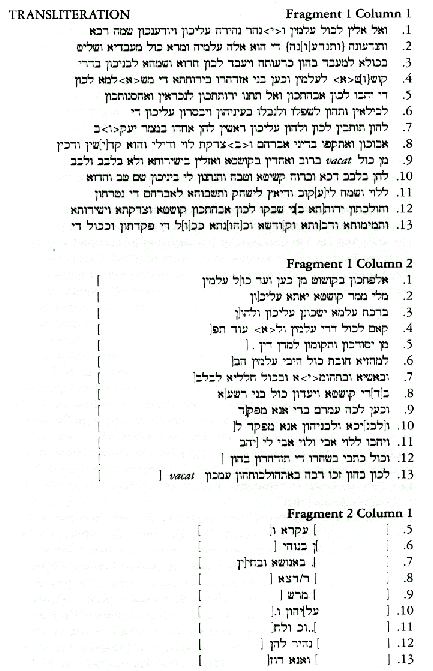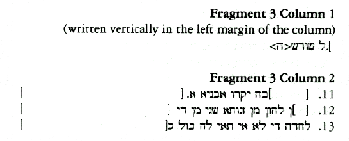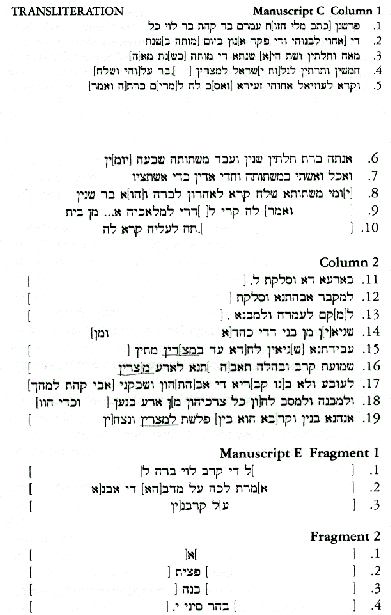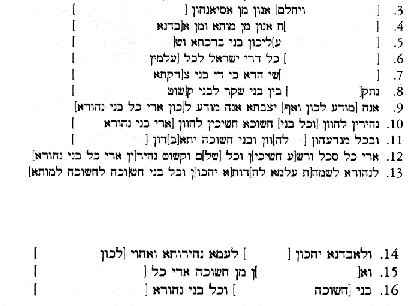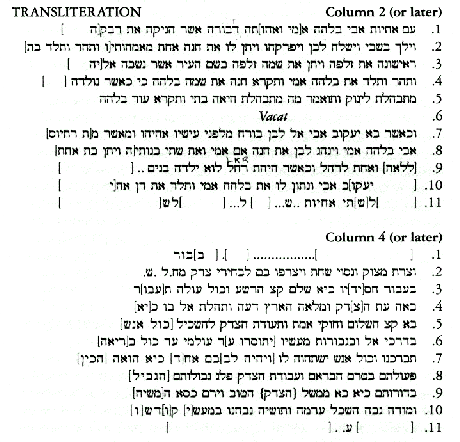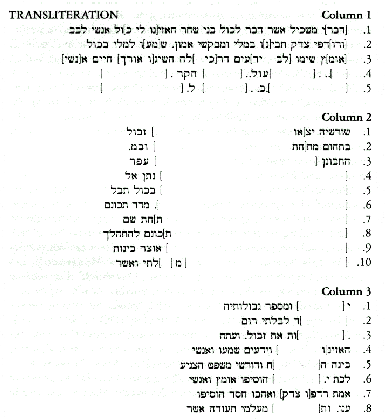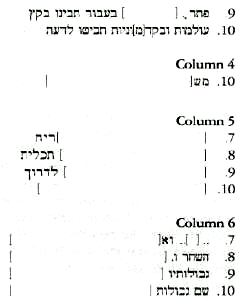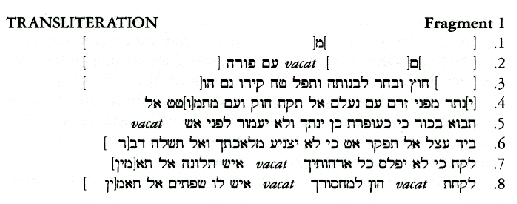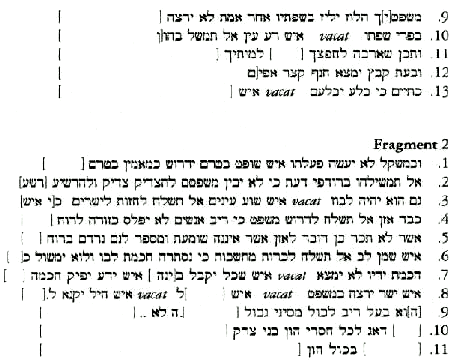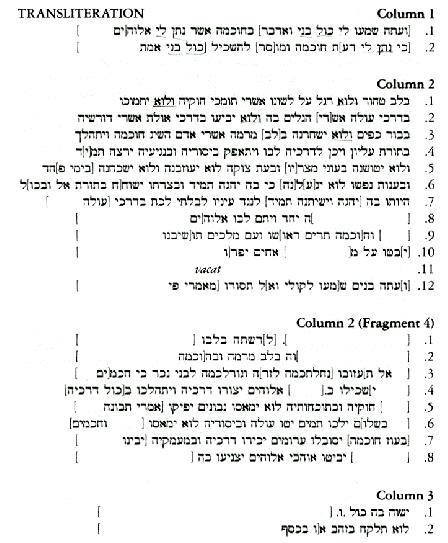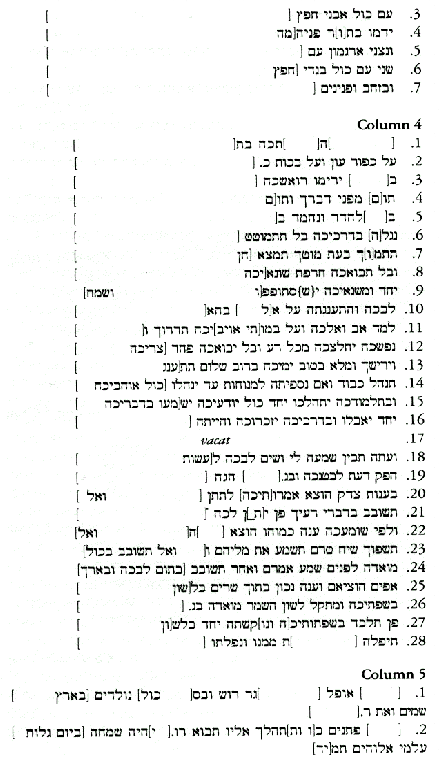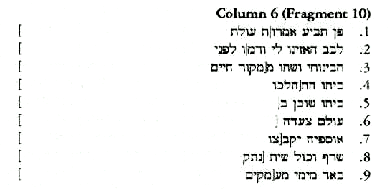Chapter 5 - Testaments and Admonitions
Life is complicated and always has been. In the ancient world, millennia before
the time of the Scrolls, one response to this fact was the development of Wisdom
literature. This type of literature expounded principles of life and made
judicious observations, often couched in the form of pithy sayings. Wisdom
literature in the Bible includes Proverbs, Job and Ecclesiastes. In the Second
Temple period this literature abounded, and new kinds of Wisdom literature
developed. One of the new forms was the ‘testament’.
Testaments had their origin
in the farewell discourses common in the Bible, such as Gen. 49 (the last words
of Jacob) and 1 Sam. 12 (the last words of Samuel). Thus testaments are speeches
delivered in anticipation of death and intended to impart the lessons of a
lifetime from a father to his sons. The most famous apocryphal example of this
type of literature is the Testament of the Twelve Patriarchs. In this collection
(which came down from antiquity in Christian circles written in Greek, although
in origin Jewish and Semitic), each of the twelve sons of Jacob speaks in turn.
Their words comprise ethical exhortation and predictions about the future.
Testamentary literature is well attested among the new materials from the
Scrolls. Testaments attached to Levi, Naphtali, Kohath and Amram have emerged.
In addition, other forms of Wisdom literature are ubiquitious in the Scrolls;
this Chapter presents several examples. When reading the Qumran testaments, the
reader may want to bear the following genealogical relationships in mind:
-
Jacob
-
Levi – Naphtali (sons of Jacob)
-
Kohath (son of Levi)
-
Amram (son of Kohath)
-
Moses - Aaron (sons of Amram)
-
Priests (descended from Aaron)
Back to Contents
27. Aramaic Testament Of Levi (4Q213-214)
Even though it is possible to harbour reservations about whether all this
material of varying emphases can, in fact, ever be made to correspond to a
single whole, it is important to note themes and imagery even in well-known
texts such as this one, which at once move across the entire spectrum of Qumran
literature and are completely harmonious with the Qumran perspective.
Here we
have the typical emphases on ‘Righteousness’, ‘Truth’, ‘Judgement’, ‘Knowledge’
and ‘Wisdom’ as opposed, for instance, to ‘Evil’ and ‘fornication’. The
‘Righteousness’ and ‘fornication’ themes at Qumran are, as we have seen,
particularly strong. Though it is perhaps possible to identify themes such as
these in literature of the Second Temple period generally, their emphasis in
documents like this one is particularly telling. It is also interesting to see
the descendants of Levi or the priests denoted in 1.2.2 as ‘a Righteous seed’.
This has clear ‘Zadokite’ implications according to some of the definitions we
have set forth above, particularly when ‘Zadok’ is taken in its esoteric sense
as denoting ‘Righteousness’. The reference to ‘Abel Mayin’ in 1.2.17 is
interesting, too. This is particularly true in view of the visionary materials
from 18-21 thereafter.
In 2 Chr. 16:4 Abel Mayin is designated as a city in Naphtali probably on the
way to Syria in the northern part of the country. In this text it is probably
being seen as the location of Jacob’s famous vision in Gen. 28:10-19 of a ladder
by which the Angels ascended to Heaven (and descended).
The visionary material
in 18-21 projects Levi as another of these heavenly voyagers who are so much a
part of the literature of Heavenly Ascents. It has much in common with the
literature of visionary recitals in Chapter 1 and that of Hymns and Mysteries in
Chapter 7. Lines 5-6 in the first column of Fragment 4 begin with the rather
typical emphasis on works Righteousness and Truth.
From Line 8 onwards, however,
after the reference to ‘Torah’ and ‘traditional interpretation’, the focus
quickly moves on to Wisdom, and is hardly distinguishable from texts like the
Admonitions to the Sons of Dawn, the Sons of Righteousness, and the Demons of
Death below.
The reference in Line 4 to Levi as a ‘friend of God’, if allowed,
also parallels similar denotations about Abraham, Isaac and Jacob, already noted
in Chapter 3. From Line 16 Column 2, the fragment shifts emphasis to
Messianic-style visions of the Kingdom reminiscent both of Dan. 2:44 and
Pseudo-Daniel collections.
Fragment 5 is, of course, a typically Righteousness-oriented apocalypse using
the by now well-known Qumran nomenclature of ‘walking’ (either in Light or
Darkness) and ‘Ways’. It emphasizes two previous, primordial ‘Righteous Ones’ of
the utmost importance to this tradition, Enoch and Noah. Manuscript B Fragment
1, is a mundane, rather typical, recital of the paraphernalia of Temple
sacrifice.
Translation
Manuscript A
Fragment 1
Column 1
(8)... this (9)... I (10)... I [washed myself] and all (11) [...then] I raised [my eyes and my
countenance] to Heaven (12)... my toes and my fingers (13) [...1 prayed
and] said, ‘My Lord, You (14) know... You alone know (15) [...all] the
paths of Truth. Put away (16) [from me... Evil and fornication. Turn away
(17) [...Wi]sdom and Knowledge and strength (18) [give to me... [to] find
Your Mercy before You (19)... that which is pleasant and good before You (20)... let [no]t any satan (here, possibly ‘enemy’) have power over me (21) [...up]on me, Lord, and bring me forward to be Your...
Column 2
(8) [Your] a[yes...] (9) Lord, [You] bl[essed...] (10)
a Righ[teous] seed. [...
Hear, please,] (11) the prayer of [Your] ser[vant Levi... to do] (12) a True
judgement for al[1 time... Do not remove] (13) the son of Your servant from [Your] pre[sence...] (14)
Then I continued on... (15) to my father Jacob and whe[n...] (16) from
Abel Mayin. Then (17) I lay down and I remained a[t Abel Mayin...] (18) Then
I was shown visions... (19) in the vision of visions, and I saw Hea[ven
opened and I saw the mountain] (20) beneath me, as high as to reach to Heav[en,
and I was on it. Then were opened] (21) to me the gates of Heaven, and an Angel
[spoke to me, ‘Levi, enter...’]
Fragment 3
(1)... your priesthood above all
flesh (2) [...And] I awoke from my sleep. Then (3) [I said, ‘This is a
vision, and thus I am amazed that I should have any vision at all.’] I [hid]
this also in my heart; to no person did I (4) [reveal it. And we went to my
(grand)father Isaac, and he also blessed me thus. Then, wh]en Jacob my father
was tithing (5) [everything that he owned according to a vow made to God, for
the first time I was at the head of the priest]s, and to me of (all) his sons he
gave...
Fragment 4
Column 1
(1) [And in the hundred and eighteenth year of my
life, the year] in which died (2) [my brother Joseph, I called my children and
their children and began to instruct] them (3) [concerning all that was in my
heart. I said to my children, ‘Listen] to the word (4) [of Levi your father, and
pay heed to the instructions of God’s friend.] I [instruct] you, (5) [my sons,
and I reveal the Truth to you, my beloved. The essence] of each of your works
(6) [must be Truth. May Righteousness always] re[main] with you, and Truth. (7)
[Then you shall have a blessed and good [harvest.] He who sows Good reaps Good,
(8) [while he who sows Evil,] his [sowing turns against him.] And now, my sons,
[teach] Torah, its interpretation and Wisdom (9) [to your sons, and Wisdom shall
be with you] as an eternal honor. He who teaches Wisdom (10) [will find] honor
[therein. He who despises Wisdom] will be given [to con]tempt and disdain.
Observe, my sons, (11) [Joseph my brother, who taught Torah and interpretation
and Wisdom. (He received) honor and became a great man, both to kings (12)...
Do not exchange Wisdom for a teacher (13)... a foreigner. He who teaches
Wisdom, all (14) [the days of his life shall be long, and his reputat]ion [shall
grow great.] In every land and country to which he goes (15) [he has a brother,
and is not like a stranger] in it, nor like a foreigner in it, neither (16) [is
he like an unfamiliar person there. For all give him honor there, because
everyone wants (17) [to learn from his Wisdom.] His [friends] are numerous, and
many seek his welfare. (18) [They seat him on the seat of honor, in order] to
hear his words of Wisdom. (19) [Wisdom is a great richness of honor for] those
who know it, and it is a treasure (20) [for everyone who possesses it. If]
migh[t]y [kings come] with a [great] (and) powerful army...
Column 2
(1) (they will not find) its hidden places, and they shall
not enter its gates, nor... (2) will they be able to conquer its walls. And
not... (3) they will see its fodder, its treasure that does [not]... (4)
for which there is [n]o price... [Any man] (5) who seeks Wisdo[m, Wisdom
[will find] him... [it will not] (6) be hidden from him... (7) and not
la[c]king... all who see[k] (8) in Truth... Torah and interpretation, (9)
Wi[sd]om that [they] teach... they are two (10)... great. You will give
(11) [...h]onor... (12) Also in books (13) [...you will b]e leaders and
judges (14)... and servants (15)... also priests and kings (16)... your
Kingdom (17) will 1[ast forever... there will be no end (18)... [the
Kingdom will not] pass away from you until (19)... in great honor.
Fragment 5
(1) [...y]ou will be darkened... (2) did not [E]noch complain... (3) Noah, and upon
whom does the guilt fall?... (4) is it not upon me and upon you, my sons?
Now, you know (5)... the
Ways of Righteousness you will aba[n]don, [and] all the ways (6)... you will
renounce, and you will walk in Darkn[ess] (7)... great oppression will come
upon you, [and] you will be gi[ve]n (8)... you will become fools...
Manuscript B
Fragment 1
(1) to offer up on the altar (anything fitting), wash
your hands and feet once again. And offer] split [woo]d. (2) [Examine it first
for an[y worms, and t]he[n offer] it up, [for] thus I saw Abraham (3) [my father
taking care regarding] anything that might restrain (him from offering the
wood). Any of [twel]ve woods [that are fitting] he to[ld] me [to] offer up on
the altar, (4) [whose smoke] rises up with a pleasant odor. These are th[eir]
na[mes:] ce[dar, juniper, almond, (5) [fir, pine, ash, cypress, fig, oleaster,
laurel, myrtle and (6) as[ph]althos. These are th[ose he said] are fitt[ing to
offer up] under the burnt offering (7) on the altar. And [when you begin to
offer up one of these [wood]s upon [the] altar and the [fire begins] (8) to burn
them, you are to sprinkle the blood] on the sides of the altar. Again, [wash]
(9) [your hands and feet of the blood, then begin to offer up] sa[lt]ed
portion[s.] As for [its[ he[ad,]...
Back to Contents
28. A Firm Foundation (AARON A - 4Q541)
The relationship of this text to the Aramaic Testament of Levi above should be
clear. In fact, there is no real reason to consider it distinct from it, but
rather simply another version or portion of it. The working title, 4QAaron, must
be seen as a convention, nothing more, though it does reflect the priestly
character of some of the material, particularly the references in Column 2.4 to
‘burnt offerings’ and being ‘a Foundation of peace’ and similar allusions,
including more ‘Foundation’ imagery in Columns 4 and 6.
The reference in 6.3 to
‘brothers’, however, would rather suggest a more direct attribution to Levi than
Aaron, though the implication might simply be the same general priestly and Levitical thrust of the two Testaments attributed to Kohath and Amram - two more
descendants of Levi - below.
The relationship of this text to extant Testament of Levi literature in other
languages, as well as to Daniel and Enoch materials - particularly as it turns
more apocalyptic in Columns 4-5 - is also strong. These columns parallel the
famous eschatological portions of the Greek Testament of Levi ME Apart from the
usual allusions to ‘Wisdom’, ‘Mysteries’ and some visionary thrust in the first
two columns, one should note in 4.1 the emphasis on ‘making atonement for all
the sons of his generation’.
This ‘atonement’ imagery is strong in other Qumran
literature like the Vision of the Four Kingdoms in Chapter 2 and the Community
Rule (viii.6-10). In the latter, it is definitively related to the Council of
the Community, who stand as both an ‘Inner Sanctum’ or ‘Holy of Holies’ for
Aaron and a ‘House’ or ‘Temple’ for Israel. It is, of course, strong, too, in
early Christianity as we have seen. The use of the imagery of a ‘firm
Foundation’, again so prominent here, is very strong in the Qumran Hymns and the
Community Rule as well, the last particularly where the Community Council and
spiritualized ‘atonement’ imagery is concerned. It is even alluded to in the New
Testament.
It is, of course, generically related to ‘Rock’ imagery in the latter
tradition. In the Qumran Hymns it is not only accompanied by this imagery and
that of ‘the Cornerstone’, but also that of the ‘Tower’, ‘wall’ and ‘Fortress’,
of the kind also associated with James, who was called in early Christian
tradition both ‘Protection of the people’ and ‘Fortress’.
The use of the word ‘swallow’ in Column 2.8 is also interesting, because of its
relevance to ‘swallowing’ imagery at Qumran generally. Though this imagery is
used here in regard to Wisdom, it usually occurs, as we have seen, in connection
with ‘sons of Belial’ or ‘sons of Darkness’ imagery generally, of the kind one
finds in Columns 4-5 of this document.
As delineated in some of the pesharim,
these last together with ‘the Liar’ are responsible for the destruction of the
Righteous Teacher. In this document, too, this imagery in turn moves in Column
4.4ff. into an allusion to ‘Lying’ and reference to ‘violence’ generally. This
last in Columns 5-6 gives way to the usual emphasis on ‘walking’, probably in
the Ways of Darkness and Light. Even the allusion here to hamas (‘violence’) is
widely paralleled in the published corpus, particularly in the Habakkuk Pesher,
as are allusions to formulae like ‘wandering astray’ (4.6), usually ‘wandering
astray in a trackless waste without a Way’ as in Column i of the Damascus
Document.
The reconstruction involving ‘crucifixion’ in Column 6 is also interesting, if
it is finally to be entertained. Here, combined with the ‘firm Foundation’
imagery, it moves into a splendid evocation of eternal life in terms of
reference to the ‘Light’ imagery so widespread at Qumran and, of course, the
beginning of the Gospel of John. This imagery has much in common with that of
the Testamental bequests and recitations associated with Kohath and Amram.
Translation
Column 1
(Fragment 6) (1)... dee[p things]... (2) who doesn’t understand.
And he wro[te]... (3) and he stilled the great sea... (4) Then the books
of Wis[dom] will be open[ed]... (5) his word... Column 1 (Fragment 2) (1)... wo[rds]... and according to the will of (2)... to me. Once more he
wrote (3)... I [sp]oke concerning it in parables (4)... was near to me.
Therefore, was far from me (5)... The visi[on] will be [profou]nd... .the
fruit ...
Column 2
(2) [from] God... (3) You shall receive the affli[cted ones]...
(4) [You] shall bless [their]
burnt offerings [and You shall establish for] them a Foundation of Your peace... (5) your Spirit, and
you will rejoice [in your God. Now] I [am proclaiming to you parable[s]...
rejoice. (6) Behold, a wise man [will understand that I am seeing] and
comprehending deep Mysteries, thus I am spec[king...] parable[s]. (7) The
Greek (?) [will not understand. But the Knowledge of Wisdom will come to you,
for you have received... [you] will acquire... (8) Pursue her (Wisdom) and
seek [her and gain possession of] her to swallow (her) down. Behold, you will
gla[dden] many... many (will have) a place...
Column 4
(1)... his Wisdom [will be great.] He will make atonement for all
the children of his generation. He will be sent to all the sons of (2) his
[generation]. His word shall be as the word of Heaven and his teaching shall be
according to the will of God. His eternal sun shall burn brilliantly. (3) The
fire shall be kindled in all the corners of the earth. Upon the Darkness it will
shine. Then the Darkness will pass away (4) [from] the earth and the deep
Darkness from the dry land. They will speak many words against him. There will
be many (5) [lie]s. They will invent stories about him. They will say shameful
things about him. He will overthrow his evil generation (6) and there will be
[great wrath]. When he arises there will be Lying and violence, and the people
will wander astray [in] his days and be confounded.
Column 5 (Fragment 5)
(1)... and those who are grieved concerning... (2)
your ju[dgment] but you will not be gui[lty]... (3) the scourging of those
who afflict you... (4) your complaint (?) will not fail and all... (5)
your heart be[fore]...
Column 5 (Fragment 1)
(1) [Behold] I saw one... (2) I saw seven rams...
(3) Some of his sons shall walk... (4) They shall be gathered to the Heav[enly Beings]...
Column 6
(1) God [will set] right error[s]... [He
will judge] revealed sins... (2) Investigate and seek and know how Jonah
wept. Thus, you shall not destroy the weak by wasting away or by [crucif]ixion... . (3) Let not the nail touch him. Then you shall raise up for your father a
name of rejoicing and for all of your brothers a [firm] Foundation. (4)...
You shall see and you shall rejoice in the Eternal Light and you will not be one
who is hated (of God).
Back to Contents
29. Testament Of Kohath (4Q542) (Plate 9)
This text belongs to the genre of pseudepigrapha like the Testament of Levi and
A Firm Foundation (Aaron A) above. All of these texts, including the one
attributed to Amram below, are associated with one or other of the principal
characters in the priestly succession; in fact, we may be witnessing a tradition
here not dissimilar to that of the Rabbinical one (e.g. the Pirke Abbot), where
one after another of the important Rabbinical figures in the line of succession
had important sayings attributed to him. Instead of a succession of rabbis,
however, this one would have consisted of priestly forebears.
The line can be
seen as starting with Noah and Enoch, descending through Abraham to Levi, and
from him on down through his son Kohath and his grandson Amram, to Moses and
Aaron. From there it moves, presumably through Eleazar and Phineas, to the
entire priestly establishment taking their legitimacy in some manner from either
their descent or their relationship to these early forebears.
This text derives its name from an allusion to Amram as ‘my son’ in Line 9 of
the Second Column, and
to Levi as the ‘father’ of the speaker in Line 11. (For Kohath’s genealogy, see
Exod. 6:16ff.) Here, we have as beautifully preserved a piece of pseudepigrapha
as one could wish.
The instructions it conserves are also of the most
high-minded, zealous, and xenophobic kind, presumably in the style of the
proverbial Phineas (also a descendant of Kohath), the archetypical progenitor of
both Maccabean and Zealot movements. In this regard, one should also note Jesus’
‘zeal’ recorded in John 2:27 and Acts 21:20’s parallel characterization of
James’ followers as ‘zealous for the Law’. These instructions are obviously
meant to apply to the entire priesthood relating to the family of Moses,
including, one would assume, the Levites themselves.
The text has been dated by those who rely on palaeography to 10075 BC, but what
one has here, regardless of the reliability of such assessments and the
typological sequences on which they are based, is not a formal or ‘book’ hand,
but rather a semi-cursive or private one.
As such, it is almost impossible to
date. A recent, .Tingle AMS Carbon 14 test done on the parchment yielded a date
of about 300 years earlier. This is obviously unreliable, and the inaccuracy is
probably connected with the imprecision of such tests generally and the multiple
variables that can skew results. It should be noted that C-14 tests in
manuscript studies tend to make documents seem older than they actually are, not
vice versa.
The crucial passage in this text is the one in Lines 5-6 of Column 1 having to
do with foreigners coming into the country - particularly, in Line 7, foreign
masters who have taken it over - and being humiliated and trampled on by them.
It is possible to read the reference to ‘violent men’ in Line 6 as
‘confiscators’ or ‘expropriators’.
As in 1 Macc. 13:36ff. , this allusion may
not simply relate to violence, but possibly to foreign taxation. It can also be
read as ‘violent ones’ as we have rendered it, which has important overtones
with other Qumran texts. A third way of reading it is as a reference to ‘men of
mixed blood (italics ours). Such a reading would strengthen the relationship of
the entire allusion to ‘Herodians’ - the family of Herod and those owing their
positions to them - who were certainly regarded as ‘hybrids’ or of ‘mixed’
parentage if not outright foreigners altogether.
However this allusion is read -
whether in one or a combination of these senses - it is a tantalizing notice,
and the antagonism to foreign control, particularly of the priesthood, should be
clear. These xenophobic instructions resemble nothing so much as the outlook of
‘the Zealots’, a militant group in the First Jewish Revolt against Rome (AD
66-70) with roots going back to the Maccabean period and similar uprisings and
independence movements in that period (second to first centuries BC).
This
nationalistic theme of antagonism to foreigners not only runs across the
spectrum of these documents, but can be rationalized to include objections to
appointment of high priests by foreigners and their gifts and sacrifices in the
Temple, which both the Pharisees and the priesthood dominated by them (i.e. the
‘Herodian Sadducees’) seemed to have been prepared to accept throughout this
period, but which the Zealots and others opposing Roman/Herodian rule in
Palestine were not.
In an all-important passage in the Jewish War, Josephus describes this
unwillingness to accept gifts
from and sacrifices on behalf of foreigners in the Temple as an ‘innovation’
which ‘our forefathers’
were unacquainted with before (2:409-14). This would include, not only the Roman
Emperor, on
whose behalf sacrifices were made daily, but also Herodians, looked upon by
‘zealot’ groups such as
these ‘foreigners’ because of their Arab and Idumaean origins.
For Josephus,
these circumstances led
directly to the uprising against Rome. From the period 4 BC-AD 7, when most of
the first-century
revolutionary activity began, the tax issue was a burning one, particularly in
the struggle between the
upper-class establishment and the masses.
Nor can these objections be seen as unrelated to those in the Damascus Document,
nor the two Letters on Works Righteousness in Chapter 6 below, about ‘pollution
of the Temple’ (one of the ‘three nets of Belial’). The Damascus Document, vi.
16 specifically raises the issue of the pollution of ‘the Temple treasure’
(followed on the same line by a reference to ‘robbing the Meek’) and graphically
delineates these pollutions in v-viii.
The conditions described in this text could, therefore, apply, not only to the
Herodian period (37 BCAD 70), where we are inclined to place the text, but also
to any time prior to that, particularly in the Maccabean period. However, it
must be appreciated that should the text date to the Maccabean period, it, like
the Testament of Levi and the Daniel cycle related to it, must be seen as
supporting a Maccabean style priesthood and their ‘Covenant of Phineas’, that
is, a native as opposed to a foreign imposed one (1 Macc. 2:26-28).
New texts
such as these, and of course the stark, apocalyptic nationalism evident across
the whole corpus from Qumran, are bringing this proposition more and more
vividly to light, as opposed to the earlier consensus that led the public to
believe that the group responsible for these writings could somehow, quite
mystifyingly, have been anti-Maccabean.
The Paean to King Jonathan, with which
we end this collection, will further corroborate this proposition. Where paying
the Roman tax was concerned, Josephus refers to it when describing the birth of
what now goes by the name of ‘the Zealot movement’ (Josephus calls it ‘the
Fourth Philosophy’). In fact, the tax issue was central to the split between Herodian Saducees and ‘opposition Sadducees’ signalled in our discussion of the
Priestly Courses/ ‘Aemilius Kills’ text above.
Josephus presents a high priest,
one Joezer the son of Boethus - the obscure priest from Egypt Herod had promoted
after marrying his daughter (i.e. a Herodian or Boethusian Sadducee) - as
successfully convincing the people to pay the tax to Rome which the Herodians
collected.
Joezer’s opposite number - someone Josephus mysteriously refers to as ‘Sadduk’
(italics ours) - he portrays as joining Judas the Galilean mentioned in Acts,
the proverbial founder of the Zealot movement, in agitating against the tax (Ant
18.4-5).
The Gospels, prefiguring Paul’s position thereafter, for their part
portray Jesus as teaching the people to pay the tax. Paul treated the issue of
paying taxes to Rome appropriately in Rom. 13. According to one perspective his
approach could not be more cynical, yet it is revealing. He applies the key
‘Law-Breaker’ terminology we find in the Scrolls and the Letter of James to
those who break Roman law not Jewish.
‘God’s Law’ he calls the law of the State,
even going so far as to portray Roman officials and tax-collectors as ‘God’s
officers’ (Rom. 13:6). According to this view, that Gospels writers after him
did not scruple to portray their ‘Jesus’ as keeping ‘table fellowship’ with
tax-collectors - even fornicators - should not be surprising.
As always in these
texts, and the Firm Foundation text above, one should note the emphasis on
‘Righteousness’, ‘Truth’, ‘Judgement’ and ‘Uprightness’, as opposed to ‘Evil’,
‘fornication’ and ‘deceitfulness’. Part of the second column of this text was
previously published under the mistaken identification of the Testament of Amram, presumably because of the mention of Amram in 2.9.
Translation
Fragment 1
Column 1
(1)... and God of Gods for all Eternity. And He will
shine as a Light upon you and He will make known to you His great Name (2) and
you will know Him, that He is the Eternal God and Lord of all creation, and
sovereign (3) over all things, governing them according to His will. And He will
give you joy and your sons rejoicing for generations of (4) the Truth, forever.
And now, my sons, be watchful of your inheritance that has been bequeathed to
you, (5) which your fathers gave you. Do not give your inheritance to
foreigners, nor your heritage to (6) violent men, lest you be regarded as
humiliated in their eyes, and foolish, and they trample upon you, for (7) they
will come to dwell among you and become your masters. Therefore, hold fast to
the word of Jacob (8) your father, and be strong in the judgements of Abraham,
and in the Righteousness of Levi and myself. Be Holy and pure (9) from all vacat
entirely, and hold to the Truth, walking uprightly without Deceitfulness, (10)
but rather with a pure heart and in a True and Good Spirit. Thus you will grant
to me a good name among you, together with joy (11) for Levi and happiness for
J[a]cob, rejoicing for Isaac and blessing for Abraham, inasmuch as you guarded
(12) and walked (in) the inheri[tance. My solos, your fathers bequeathed to you
Truth, Righteousness, Uprightness, (13) integrity, pur[ity, Holiness and the
priesthood. In accordance with what you have been commanded, and according to
all that
Column 2
(1) I have taught you in Truth, from now and for
al[1 Eternity... (2) the words of the Truthful saying. There will come upon yo[u... (3) eternal blessings shall rest upon you. And there shall b[e...
(4) enduring to all the generations of Eternity. And no longer shall you...
(5) from your Foundation, and you shall endure to pronounce judgements... (6)
to reveal the sin of all the eternal sinners... (7) and the Wicked and in the
depths of the sea and in all the hollows of the earth... (8) in [gener]ations
of Truth, while all the sons of Evi[l] will pass away... (9) And now, you,
Amram, my son, I appoi[nt... (10) and [to] your [son]s and to their sons I
appoint... (11) and they bequeathed it to Levi my father, and Levi my father
[bequeathed it] to me... (12) and all my books as a testimony, that you take
heed of them... (13) Great merit [will come] to you from them as they
accompany you in your affairs.
Fragment 2
Column 1
(6)... his sons... (7) among mankind and among liv[ing
things]... (12) a Light. Instead... (13) and I . ..
Fragment 3
Column 1
(in the margin) his root.
Column 2
(11)... the stones will call... (12) them from all
fornication very much.
Whoever... (13) exceedingly, for he has no...
Back to Contents
30. Testament Of Amram (4Q543, 545-548)
The Testament of Amram, if indeed we can call it this - Amram per se is
mentioned only in Manuscript C - is one of the most splendid apocalyptic and
visionary works in the corpus. In it, many of the themes we have encountered in
the works discussed above come together in a fairly rationalized eschatological
whole.
These include the usual ‘Light’, ‘Darkness’, ‘Belial’, ‘Righteousness’,
‘Truth’, ‘Lying’ and ‘Watcher’ vocabulary, including the very nice allusions to
‘sons of Righteousness’ - which we have already identified as a variant of the
‘sons of Zadok’ terminology - ‘sons of Light’, ‘sons of Darkness’ and ‘sons of
Truth’, again widely disseminated through the whole corpus.
Added to these we
have the very interesting allusion in Manuscript B to ‘serpents’ and ‘vipers’
encountered in many texts from Qumran (e.g. CD,v.14), not to mention a
well-known parallel imagery in the Gospels (Matt. 3:7, 23:33, etc.).
Though we cannot be sure that the several fragments and manuscripts represented
in this reconstruction in fact belong to the same composition, nor that they can
be sequentially arranged in the manner shown; there are, in fact, overlaps which
seem to indicate multiple copies of a single work and, in any event, they can be
grouped typologically together. In addition, because of internal and external
similarities, they are probably part of a cycle of literature associated with
Moses’ father Amram.
This, in turn, is related to the Testament of Kohath
material and the Levi cycle in general. Manuscript C most fully preserves the
beginning of the work, but has little in common with Manuscript B and Manuscript
?, which on the basis of content alone obviously belong together. Manuscript ?
is referred to in this way in the literature, no more complete designation
having yet been made. Manuscript C, which includes the names of the principal
dramatis personae like Amram, Kohath, Levi, Miriam and Aaron, pretends to be
more historical.
It and Manuscript E even give some of the ages of these
characters, which are widely out of line with any real chronological
understanding of the Exodus sojourn. The surviving fragments do not, however,
show any knowledge of a relationship between Miriam and Hur, as suggested in
Chapter 3, unless Uzziel and Hur can be equated. One should also note the
anachronistic reference to Philistines in 2:19, reflected perhaps too in the Era
of Light text in Chapter 8.
It is in Manuscript B, however, and the undesignated one succeeding it, that
truly splendid material, which can hardly be referred to as testamentary,
emerges. This consists again of a visionary recital of the most intense kind,
similar to that in Chapters 1 and 2, the Firm Foundation materials above and in
Chapter 7. Here, too, several identifications are made. First, in Line 13 of
Manuscript B, the Enochic ‘Watchers’ are identified with ‘the serpent’ with ‘the
visage of a viper’- evidently the same serpent that is connected to the downfall
of man in the Adam and Eve story. We have probably already encountered him, as
well, in the Tree of Evil text above.
Three more names are accorded him: ‘Belial’, ‘Prince of Darkness’ and ‘King of
Evil’. This latter name, Melchi Jeshua, is to be contrasted with the well-known
terminology integrally involved with Jesus’ Messianic and eschatological
priesthood, Melchi Zedek / ‘King of Righteousness’, (Heb. 5-7), a subject that
has interested scholars heretofore. The latter has two other synonyms, the
Archangel Michael, the guardian Angel of Israel, and the Prince of Light
(E.3.2).
Tied to these are the other usages, noted above, relating to ‘Righteousness’,
‘Truth’, ‘Light’ and ‘Lightness’, ‘Dark’ and ‘Darkness’, ‘Lying’ and the like.
The ‘Way’ terminology, again widespread at Qumran and known to early
Christianity, is also strong here. All these allusions have their counterparts
in their application to the dramatis personae of interest to the Qumran writers
and their historiography.
The text ends with perhaps the most marvellous paean
to Light and Dark of any literary work, apart from the Chariots of Glory below
and the well known prologue to the Gospel of John.
Translation
Manuscript C
Column 1
(1) A copy [of the book of the words of the vis]ion of
Amram the son of Kohath, the son of Levi: all (2) that [he revealed to his sons
and that he commanded t]hem on the day [of his death, in] the year (3) one
hundred and thirty-six, whi[ch] was the year of his death, [in the o]ne hundred
(4) and fifty-second year of the exil[e of Israel to Egypt... upon [him, and
he sent] (5) to call Uzziel his youngest brother, and [gave] to him [in
marr]iage [Miri]am [his] daughter. [For he said] (6) ‘You (Miriam) are thirty
years old.’ Then he gave a wedding feast seven [day]s long, (7) and ate and
drank and rejoiced at the feast. Then, when (8) the Mays of the wedding feast
were completed, he called for Aaron his son. Now, [h]e (Aaron) was a man of... years of age (9) [...and he said] to him, ‘Call... and Malachijah...
from the house of (10)... above. He called him... Column 2 (11) in this
land, and I went up to... (12) to bury our fathers. And I went up... (13)
to [a]rise, to bind and pile sheaths and to build... (14) gre[a]t from the
sons of my uncle, all togeth[er... and from] (15) our excee[ding great
labors, [until in Egy]pt there died... (16) the rumor of war and unrest
returned... to the land of E[gypt...] (17) to meet and [they had] not
bui[lt gr]aves for their fa[th]ers. Then [my father Kohath] released me [to go,]
(18) to build and to get [all their needs] for the[m from the land of Canaan.
[And while] (19) we [were] building, wa[r broke out between] the Philistines and
Egypt, and... was winn[ing...]
Manuscript E
Fragment 1
(1)... that Levi his son sacrificed to... (2) I
said to you at the alt[ar] of stop[e...] (3) [con]cerning sacrifice[s...]
Fragment 2
(2) I rescued... (3) he built... (4) at Mount Sinai... (5) a
great blessing at the bronz[e]
altar... (6) from among all the people on earth his [son] will be exalted as
a priest. The[n...] (7) and
his sons after him, for all the generations of eternity in Tru[th...] (8) and
I awoke from the sleep of my eyes, and [I] wrote down the vision... (9) I
went out from the land of Canaan, and it happened to me just as he said...
(10) exalting, and afterwar[d], in the twen[tieth] year, [I returned to the land
of Canaan] (11)... you were...
Manuscript B
Fragment 1
(9) [...1 saw Watchers] (10) in my vision, the
dream-vision. Two (men) were fighting over me, saying... (11) and holding a
great contest over me. I asked them, ‘Who are you, that you are thus empo[wered
over me?’ They answered me, ‘We] (12) [have been em]powered and rule over all
mankind.’ They said to me, ‘Which of us do yo[u choose to rule (you)?’ I raised
my eyes and looked.] (13) [One] of them was terr[i]fying in his appearance,
[like a serpent, [his] cl[oa]k many-colored yet very dark... (14) [And I
looked again], and... in his appearance, his visage like a viper, and
[wearing...] (15) [exceedingly, and all his eyes...]
Fragment 2
(1) [...em]powered over you... (2) [I replied to him,] ‘This
[Watcher,] who is he?’ He answered me, ‘This Wa[tcher...] (3) [and his three
names are Belial and Prince of Darkness] and King of Evil.’ I said, ‘My lord,
what dom[inion...?’] (4) [’and his every way is darkened, his every work
da[rk]ened. In Darkness he... (5) [Yo]u saw, and he is empowered over all
Darkness, while I [am empowered over all light.] (6) [...from] the highest
regions to the lowest I rule over all Light, and over al[1 that is of God. I
rule over (every) man]
Fragment 3
(1) [of His grace and peace. Over all the sons of Lig]ht have] I been
empowered.’ I asked him, [What are your names... ?’] (2) He [s]aid to me,
‘[My] three names are [Michael and Prince of Light and King of Righteousness.’]
Manuscript ?
Column 1
(1)... tribes... (2) to them and all [his] ways [are
True...] (3) [and he will heal] them of all their ills... (4) them from
death and from de[struction...] (5) [o]ver you, blessed sons... (6) all
the generations of Israel for[ever...] (7) angry at me, for the sons of
Ri[ghteousness...] (8) between the sons of Lying and the sons of Tr[uth...] (9) I [will make known to you;] certainly I will inform y[ou that all the
sons of Light] (10) will be made Light, [whereas all the sons] of Darkness will
be made Dark. [The sons of Light...] (11) and in all their Knowledge [they
will] be, and the sons of Darkness will be dest[ro]yed... (12) For all
foolishness and Evi[1 will be darkened, while all [pea]ce and Truth will be made
Ligh[t. All the sons of Light] (13) [are destined for Light and [eternal j]oy
(and) [re]joic[ing.] All the sons of Dark[ness] are destined for [Darkness and
death] (14) and destruction... Lightness for the people. And I shall reveal
[to you...] (15) from Darkness, for all... (16) the sons of [Darkness...] and all the sons of Light...
Back to Contents
31. Testament Of Naphtali (4Q215)
The Testament of Naphtali has long been known in its Greek form, which like the
Testament of Levi is part of the apocryphal Testament of the Twelve Patriarchs.
The original Hebrew or Aramaic version (it was not known which it might be) had,
it was long thought, perished in antiquity. Then, in 1894 M. Gaster drew the
attention of the scholarly world to medieval manuscripts that contained two
slightly different Hebrew versions of the work. The relationship between the
Greek and the Hebrew has been a matter of some debate ever since.
The surviving portions of the Qumran version of the work, presented here, will
doubtless fuel the debate still further. Column 2 preserves the Hebrew form of
the Greek Testament of Naphtali 1:9, 11- 12, along with previously unknown
details. Column 4 does not parallel any portion of the Greek, and has an
eschatological thrust not found in the Greek Testament of Naphtali.
The text, as
reconstructed from two separate fragments - and again the reconstruction is not
certain - follows the pattern of the Testament of Amram. Here, a more or less
straightforward historical narrative is followed by an eschatological
presentation of the most intense nature. In fact, this one develops, even in the
portion which is extant, into outright Messianism, so that this text, like
several others above, could be added to Chapter 1. The prosaic narrative of
Column 2 is followed by the ecstatic visionary recital in Column 4.
Only Lines 1-5 in Column 2 parallel Greek Naphtali text 1:9-12. The latter then
returns to a rather humdrum admonition, while the present text develops as
below. We have inserted the name Rotheos from the Greek text for Bilhah’s father
in Line 7 for purposes of exposition and not because it actually appears in the
Hebrew text.
The name itself may have been a comparatively late invention
without a Hebrew original, but some name probably does appear in the original.
Here one encounters the usual Messianic vocabulary of ‘the Pit’ (CD,vi.3-9), Hassidav (‘His Pious Ones’), ‘Knowledge’, ‘Righteousness’, ‘Truth’, and that
predestination implicit in recitals like this in, for instance, the Damascus
Document and throughout the already published Qumran Hymns.
Here in 4.8, the
actions of ‘the Righteous’ (those ‘saved’ at the end of time) are known or
prepared ‘before ever they were created’ (see CD,iv.4-7 on ‘the sons of Zadok’
and IQH,ix.33-35). Both Paul and James are familiar with this sort of language,
and early church literature preserves the tradition that James ‘was consecrated
(‘Holy’) from his mother’s womb’ (E.H. 2.23.4). For his part, Paul is familiar
with the vocabulary of ‘the Service of Righteousness’, applying it in the
passage from 2 Cor. 11-12 we have already noted above to his opponents among the
‘Hebrew’ ‘archapostles’, whom he calls Satan’s ‘servants’ and ‘dishonest workmen
disguised as apostles of Christ’.
In addition to noting ‘the Ways of God’ in
4.6, language we shall encounter in the Mystery of Existence text in Chapter 7,
the text also draws attention to ‘His mighty works’. These ‘works’ or ‘mighty
wonders of God’ are to a certain extent delineated in the War Scroll. Recast in
the New Testament as curings, raisings, speaking in tongues, exorcisms, and the
like, at Qumran, in keeping with its more apocalyptic and yet this-wordly
approach, they are the battles and final eschatological actions that God has
undertaken or will undertake on behalf of his chosen ones, those He ‘loves’.
The
text very definitely looks forward to the Messianic era, and in doing so, in
4.4ff., turns more and more ecstatic. This material is not paralleled in the
extant Greek version, which turns, as noted, more prosaic at this point. In the
first place the text introduces in 4.1 another new expression, ‘the Elect of
Righteousness’, paralleled in Hymns, ii. 13 in a section referring to ‘the Way’,
‘zeal’ and ‘marvellous Mysteries’.
Except for the use of the term ‘Wicked” or
‘Evil’, the era of which is now past, the text is strictly positive. With the
arrival of ‘the time of Righteousness’, ‘the era of Peace’ has come, when ‘the
Laws of Truth’ and ‘the Ways of God’ will be observed to ‘all Eternity’ (4.4-5).
Connected with this one gets the evocation of the ubiquitous ‘Throne’ imagery
encountered throughout
these documents, and the text announces that ‘the Rule of Goodness and
Righteousness has come’ and God has ‘raised up the Throne of his Messiah’ (4.9).
No more triumphant proclamation could be imagined. It is for this reason that we
have called the movement responsible for these works ‘the Messianic Movement in
Palestine’. There is no way this can be gainsaid and we stand by this
determination.
That the so-called ‘Zealot’ movement was also permeated by Messianism is
confirmed by Josephus at the end of the Jewish War, when he contends that the
thing that most moved the Jews to revolt against Rome in AD 66-70 was an obscure
and ambiguous prophecy ambiguous because it was capable of multiple
interpretations, one Pharisaic like his own and one like that at Qumran - that a
World Ruler would come out of Palestine, i.e. the Star Prophecy (6.312-14).
The term ‘Elect of Righteousness’ in this text is also interesting. Again, in
the Damascus Document the ‘sons of Zadok’ are defined as ‘the Elect of Israel,
called by name, who will stand at the end of time... and justify the
Righteous and condemn the Wicked’ (iv. 3-7; italics ours). The notion of ‘the
Elect’ is an important one at Qumran.
This portion of the Testament of Naphtali
draws the links between ‘the sons of Zadok’ and ‘the Righteous Elect’ even
closer. It is, of course, also a variation of ‘the sons of Righteousness’
terminology.
The usage ‘hearts’ or ‘heart’ (4.7) is also an important one at Qumran often
connected with these kinds of allusions, denoting ideological purity. ‘The Ways
of God and the mightiness of His Works’ in Line 4.6 are those that will reign in
the Messianic era; they have their counterpart both in this document and in
others in the ‘works’ expected of man. This is ‘works Righteousness’ with a
vengeance.
Translation
Column 2 (or later)
(1) with the paternal aunts of Bilhah, my m[other, and her
sister, Deborah, who nursed Rebeccah... (2) And he (the father) went into
captivity, but Laban sent and rescued him. Then he (Laban) gave him (Rotheos)
Hannah, one of his maidservant[s. And she conceived and bore] (3) her first
[daughter], Zilpah. And he gave her the name Zilpah after the name of the city
to wh[ich] he had been taken captive. (4) Then she conceived and bore Bilhah, my
mother. Hannah named her Bilhah because, when she was born, (5) she hurried to
suckle. So she said, ‘My, how my daughter is in a hurry.’ So from then on she
was called Bilhah. (6) vacat (7) And when Jacob my father, fleeing from Esau his
brother, came to Laban, and because [Rotheos], (8) the father of my mother
Bilhah, di[ed], Laban took charge of Hannah my grandmother and her two
daughters. He gave one daughter (9) to Leah and one to Rachel. When it came
about that Rachel was not bearing sons... (10) Jaco]b, my father. And Bilhah,
my mother, was given to him; so she bore Dan [my] brother [...(11) tw]o
daughters...
Column 4 (or later)
(1) [...in] the Pit (2) and great distress and devilish
trials. And some among them
shall be purified to become the Elect of Righteousness... (3) for the sake of
His Pious [On]es. For
the era of Evil has been completed, and all sinfulness will pas[s away]; (4) the
time of Rightousness
has come, and the earth will be full of Knowledge and praise of God. F[or] (5)
the era of peace has come, and the laws of Truth and the testimony of
Rightousness, to teach [all mankind] (6) the Ways of God and the mightiness of
His works; [they shall be instructed until all Eternity. All cr[eation] (7) will
bless Him, and every man will bow down before Him in worship, and their he[arts
will be] as one. For He [prepared] (8) their actions before ever they were
created, and [measured out] the service of Righteousness as their portion (9) in
their generations. For the rule of Goodness (Righteousness) has come, and He has
raised up the Throne of the [Messiah.] (10) And Wisdom will increase greatly.
Insight and understanding will be confirmed by the works of [His] Holiness...
Back to Contents
32. Admonitions To The Sons Of Dawn (4Q298) (Plate 10)
On the surface, there is nothing astonishing about this text and no reason why
it should be written in an unknown script, called earlier by some scholars
‘cryptic’. We have been able to decipher it and provide the following chart,
which equates the letters used in the text with their corresponding Hebrew
forms:
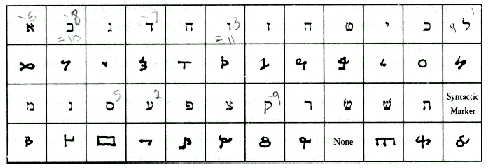
The letters used are not those of 4Q186, another work using a kind of cryptic
script. 4Q186, which has been known for some time, mixes a few words written in
the Greek and Paleo-Hebrew alphabets with those in ordinary square Hebrew
letters. Furthermore it is inscribed in mirror writing. By contrast, the
Admonitions to the Sons of Dawn does not mix scripts, moves from right to left,
and relies on 23 more or less arbitrary symbols.
It also uses a character or symbol, perhaps a syntactic marker or null
character, which has no equivalent in the Hebrew alphabet. Null symbols serve no
other function than to complicate a script’s decipherment. In some cases, a
script of this kind may not even be ‘cryptic’ at all, but simply have not come
down to us and therefore be ‘unknown’. Given the nature of the letters of this
script, however, and the correspondences we have worked out, this is unlikely.
Like ‘Wisdom’ texts generally, the text before us follows a relatively calmer
style similar to that of the
Sons of Righteousness (Proverbs) and the Demons of Death (Beatitudes) that
follow, and large
portions of the Children of Salvation (Yesha’) and the Mystery of Existence at
the end of Chapter 7. In
Line 1.2, it is addressed to ‘the pursuers after Righteousness... and the
seekers of Faith’.
These are
important allusions when the motifs we have been signaling in this work are
considered. The first, in
particular, is important, when it comes to considering the last column of the
Damascus Document at the end of the next Chapter. This column ends, as we shall
see, with a variation of this usage, well known in Jewish religious activity:
midrash (seeking/ pursuing or homiletical interpretation).
It contains the usual
allusions to ‘the storehouse of Knowledge’, ‘the Glorious abode’, ‘Meekness’,
‘humility’, ‘seeking judgements’, and ‘the men of Truth’, which are also part of
the vocabulary of the next two texts in this Chapter and of Chapter 7. Line 3.7
counsels ‘the men of Truth’ to ‘pursue Righteousness and love Piety’.
Once
again, if the reconstruction is correct, we have an allusion to the
Righteousness/ Piety dichotomy so much a part of the consciousness of this
group. The ‘Faith’ allusion, too, resonates, however tenuously, with well-known
evocations of this notion in Paul/James in early Christianity.
The first and introductory line of this text, however, is not cryptic. It is
written in normal Hebrew, and evokes an interesting character known from both
the Community Rule and the Damascus Document, ‘the Maskil’ - a synonym probably
for ‘the Teacher’ or the Righteous Teacher. The allusion is also widespread,
albeit somewhat mysteriously, in Psalms.
The references in the Community Rule and the Damascus Document are interesting
in themselves. In 1QS, iii.13, the Maskil teaches ‘the sons of Light’ about
‘their works’ and ultimate Heavenly or infernal rewards. In ix. 12 he is
commanded to be ‘zealous for the Law and the Day of Vengeance’.
The context of
these two texts is one that will relate to our discussion of baptismal
procedures and the ‘Way in the wilderness’ with regard to the Sons of
Righteousness (Proverbs) text below. In CD, xii.20 and xiii.22, the Maskil is to
‘walk in the Laws’ until the ‘standing up of the Messiah of Aaron and Israel in
the last days’ and the ‘visitation of the land’.
The eschatological implications
of all these allusions coupled with the activities of the Maskil are quite
explosive. We have already discussed the terminology ‘standing up’ as implying
possibly either ‘being resurrected’ or a ‘return’, as well as the more
straightforward ‘arising’/’coming’. In CD, xiv.18, this ‘Messiah of Aaron and
Israel... will (or ‘did’) atone for their sins’ (italics ours).
As we have
suggested, contrary to the well-known ‘two-Messiah’ theory of early Qumran
scholarship, these references to ‘the Messiah of Aaron and Israel’ in the
Damascus Document are singular not plural. The verbs and verbal nouns connected
with them are singular too. This is important, and one possible explanation for
it is that it is evoking a Messiah with both priestly and kingly implications,
like the somewhat similar recitations of Hebrews.
The doctrines that follow, however fragmented or innocuous, have to be seen as
the special provenance of this Maskil. The Demons of Death (Beatitudes) at the
end of this Chapter begins with the related predicate lehaskil (‘to teach’) and
reads as follows: ‘For He gave me the Knowledge of Wisdom and instruction to
teach all the sons of Truth.’ It is quite likely, as we shall see, that in this
we have a synonym for the sons of Dawn.
On the other hand, the kind of activity
hinted at in Line 10 Column 3 -‘to understand the era of Eternity and inquire
into the past so as to know...’ (presumably ‘the hidden things’ of Line 8) -
is precisely the kind of activity that the Talmud decries, i.e. those who look
into the past and the future will have no share in the world to come (b. Hag
11b). This single reference probably provides a better explanation for the
text’s cryptology than anything else.
The Hebrew allusion ‘sons of Dawn’ may also obliquely refer to some kind of
all-night community vigils mentioned in the Damascus Document, a part of the
backdrop to the Koran as well. This would not be the only Qumran motif that has
found its way, tantalizingly, into the latter recitation. Even Sura 89 bears the
not unparallel name, ‘the Dawn’, and quite a few suras refer to these vigils.
On
the other hand, the phrase may simply have a more esoteric or mystical sense
relating to an idea of coming into Light. In fact, the best explanation of it,
as we shall also see in our discussion of the Sons of Righteousness (Proverbs)
text below, is probably as a synonym for ‘sons of Light’, though it should be
appreciated that esoteric Qumran expressions like these are capable of multiple
levels of meaning. In order to make our discussion of these cryptic Admonitions
to the Sons of Dawn complete, we should probably borrow an allusion from the set
of admonitions that follow, that is ‘the Sons of Righteousness’.
There are at
least two allusions to ‘sons of Righteousness’ in the column of the Community
Rule referring to the Maskil mentioned above (iä.20-22), which early scholars
often tried to dismiss as scribal errors. In addition to what we have outlined
above, the avalanche of images in these columns in the Community Rule are
startling; as they relate to the Maskil they are worth recording.
The Maskil is ‘to make known to and teach the sons of Light’ (the sons of Dawn?)
‘the Ways of Light’ and how to ‘be reckoned among the Perfect’, including, it
would appear, ‘justification’, ‘works’ and the like. In particular, he is to
instruct them in baptismal procedures, which include being ‘purified by the Holy
Spirit’, ‘looking upon the Living Light’ (compare this with ‘the Living Waters’
in the Demons of Darkness and Mystery of Existence texts below in Chapter 7),
and ‘walking in Perfection in all the Ways of God, which He commanded concerning
His appointed times (obviously including those of the calendar in the preceding
Chapter), and not straying either right or left, nor treading on even one of His
words’ (italics ours).
One should compare this last turn of phrase to Jesus on ‘not one jot or tittle
of the Law’ in Matt. 5:18’s Sermon on the Mount and James 2:8 on ‘breaking one
small point of the Law’. One should also compare it to Paul’s attack on these
positions (presumably in his response to James) in his development of Abraham’s
‘Righteousness’, being ‘sons of God’ through faith, and Jesus’ being ‘cursed by
the Law’ in Gal. 3-4, which we also set forth below in connection with the end
of the Damascus Document: ‘You keep special days and months and seasons and
years’, which he calls ‘weak and beggarly’ (Gal. 4:10-11; italics ours).
A third reference to ‘the sons of the Zaddik’ in another pregnant passage of the
Community Rule (ix), mentions the Maskil, ‘walking in Perfection’, ‘the Holy
Spirit’, and more startlingly even than these, that ‘this is the time of the
preparation of the Way in the wilderness’. This is specifically tied in exegesis
to the Maskil’s ‘preparation of the Way’ by ‘teaching the Miraculous Mysteries’.
The reader will recognize this pregnant passage from Isa. 40:1-3 as that used to
describe John the Baptist’s activities in the wilderness, including most notably
baptism It is clear that these ‘Mysteries’ and baptismal procedures that ‘the
Maskil’ is to teach the sons of Dawn - here delineated in cryptic script - are
to be seen as in some way part of the preparation (probably ‘in the wilderness’)
for ‘Perfection’ and whatever ‘Crown of Glory’ and ‘eternal Light’ was
envisaged.
Translation
Column 1
(1) [The word]s of (the) Maskil (Teacher) that he spoke to all the sons
of Dawn (cryptic script begins): Give e[ar to me], all men of heart (2) and
those who [pus]sue Righteousness: you will und[er]stand my words and be seekers
after Faith. H[ea]r my words with [all your (3) strength. Lis[ten]...
[kn]owing the ways of... [ac]hieve [long] life, men of (4)... search out...
Column 2
(1) its roots reach [out]... a Glorious abode (2) in the depths be[low]... and in them. (3) Consider... dust (4)... God gave (5)...
on all the earth (6)... he measured their setting (7)... under the name of
(8)... their setting, to go about (9) ... a storehouse of Understanding (10)... and which...
Column 3
(1)... and recounting its boundaries (2)... not to be on high (3)... the Glorious abode.
And now, (4) give ear... and knowing, hear. And men (5) of Understanding,... and those seeking
judgement, humility, (6)... add strength. And the men of (7) Truth, pursu[e
Righteousness] and love
Piety; add (8) Meekness... the hidden things of the testimony, which he (9)
solved... so that you
understand the era (10) of Eternity, and examine the pa[s]t, so as to know...
Column 5 (8)...
destruction (9)... to tread... Column 6 (8) of the dawn... (9) its
boundaries... (10) he placed
boundaries...
Back to Contents
33. The Sons Of Righteousness (Proverbs - 4Q424) (Plate 11)
In this text, another typical ‘Wisdom’ text, there is the usual Qumran
vocabulary of ‘Judgement’, ‘Riches’, ‘Knowledge’, and in Line 1.9, an additional
one - ‘zeal for Truth’. This is preceded and followed by an interesting
additional evocation of ‘deceitful’ or ‘cunning lips’, which will also be of
interest in the parallel admonitions which follow next in the Demons of Death
(Beatitudes). In 1.13 there is a curious reference to ‘swallowing’, in this case
coupled with a reference on the same line to ‘the Kittim’.
A conjunction of this
kind is always interesting, but its fragmentary nature does not permit any
further analysis. Still, the expression Kittim has little evident relationship
to the rest of the text and usually relates in some way, as we have seen, to
foreign, overseas armies coming from the West, either Macedonian or Roman.
We have already extensively discussed the allusion in 3.10 to ‘Sons of
Righteousness’, with which the extant text closes, above. It is not only a
verbal parallel, but probably also a synonym for ‘the sons of Zadok’,
particularly when this expression is taken in its esoteric sense. In Lines
2.8-11 the expression is coupled with allusions to ‘the removers of the
boundary’ and ‘Riches’, both also paralleled in Columns i and iv of the Damascus
Document, not to mention the last column of the Damascus Document which we
translate at the end of the next Chapter.
In Line 8, it is preceded by another
curious reference: ‘zeal’ (of a soldier?). It is not uninteresting that this
‘zeal’ is also paralleled in the allimportant aftermath of the exegesis of ‘way
in the wilderness’ in Column ix.24 of the Community Rule discussed above - ‘zeal
for the Law’ and ‘the time of the Day of Vengeance’.
Translation
Fragment 1
(2)... with a fruitful man... (3) outside and chooses to build
it, and he covers his wall with plaster, as well as... (4) it will fall off
under the rain. Don’t take legal instruction from a deceitful person and don’t
go, young man, with someone who is unsta[b]le. (5) For just as lead melts, so
before a fire he will not stand. (6) Do not put a slackard in charge of an
important task, for he will not carry out your charge. And don’t send (him) to
pick (7) some[thing] up, for he will not pay attention to your specifications.
Do not tr[ust] the complainer (8) to get provisions for your needs. Do not trust
the man of cunning lips... (9) your Judge[m]ents. He will certainly speak
deviously, not being zealous for Truth... (10) with the fruit of his lips... Do not put the man with a covetous eye in charge of Rich[es...] (11) And
arrange what remains to suit yourself... your dead (?)... (12) and in the
time of the harvest he will be found unworthy, quick to anger... (13) Kittim,
because he will surely swallow them... A man...
Fragment 2
(1) and will not do his work carefully. The man who judges before
investigating is like someone who believes before ... (2) Do not give him
authority over those pursuing Knowledge, for he will not understand their judgement, to justify the Righteous and condemn [the Wicked...] (3) he will
also be robbed. Do not send the man of poor eyesight to look for the Upright,
fo[r...] (4) Do not send the poor of hearing to seek judgement, for he will
not carefully consider disputes between men.
Like someone winnowing wind... [Like a...] (5) who doesn’t investigate, so
is someone who
speaks into any ear that doesn’t listen or who tries to talk to a drowsy man,
who falls asleep with the spirit of... (6) Do not send the hard-hearted man
to discern thoughts, because his heart’s Wisdom is defective, and he will not be
able to control... (7) nor will he find the discernment of his hands. The
clever man will profit from Understanding. A Knowing man will bring forth Wisdom... (8) An Upright man will be pleased with judgement... A man... A
soldier will be zealous for...
Back to Contents
34. The Demons Of Death (Beatitudes - 4Q525)
(Plate 12)
This next text has been called ‘the Beatitudes’, comparing it to famous
recitations of a parallel kind in Ecclesiasticus (Ben Sira) and the Sermon on
the Mount in the Gospel of Matthew. This is perhaps a misnomer. Once again, we
have a typical ‘Wisdom’ text here, but one also rich in the vocabulary of
Qumran. Superficially, the text is fairly straightforward and commonplace. As
such, it has much in common with the Sons of Dawn and Sons of Righteousness
(Proverbs) materials above - at least Columns 1-3 do.
But as in previous visionary recitals like the Testament of Naphtali, the piece,
as reconstructed, grows more apocalyptic in columns 4-5, which are full of the
language of Righteous indignation. Though the original order of the portions is
speculative and though it might reasonably be queried whether all fragments
really belong together, it is reasonable and convenient to assign Fragment 1 to
the beginning of the work.
The tone of the first three columns even part of the
fourth - is more restrained than what develops towards the end, and we are
clearly in the first-person milieu of the admonitions of the Maskil in the Sons
of Dawn recital above.
Again we come upon the familiar vocabulary of Qumran. For instance, ‘the heart
of Deceitfulness’ language in Line 3 Column 2 is echoed in the Community Rule,
viii.22 and ix.8 dealing with barring from ‘table fellowship’, common purse and
mutual activity - subjects we shall also have occasion to discuss in Chapter 6
in relation to the end of the Damascus Document. One should note that throughout
these Translations, the reference to hok / hukkim as in Line 1 (statutes,
ordinances, or laws) is an equivocal one. Often we render it ‘statutes’, but
where the occasion arises it can be rendered ‘laws’.
The reason it is important is that in the exegesis of Isa. 40:3 referred to
above applied in two places to the activities of the Community in the
wilderness, ‘zeal’ or ‘he who is zealous for’ is tied to it. In 1QS,ix.24,
following the second exegesis and reference to ‘the Maskil’, the actual words
are: ‘and he shall be as a man zealous for the Law, whose time is the Day of
Vengeance.’
The ‘Way’ terminology is also defined in viii. 15 in the first of
these exegeses as ‘the study of the Torah’ (midrash ha-Torah), an allusion that
will also emerge in the last line of the Damascus Document below. In this text,
too, not only do we have an allusion to ‘Way’ and ‘Ways’, and another favourite,
‘walking in the Way of’, but also ‘Watcher’, ‘Evil’, ‘Knowledge’, ‘Mysteries’,
and ‘Perfection’ language (cf. Matt.
5:48: ‘therefore be Perfect as your Father in Heaven is Perfect’, itself tied in
documents like the
Community Rule to the language of ‘walking in the Way of and, of course, the
allusion to Noah as
‘Perfect and Righteous in his generation’ in Gen. 6:9), and an allusion in
Column 4.20, combining both
‘Meekness’ and ‘Righteousness’ terminologies - ‘the Meekness of Righteousness’.
In Column 5.4 there
is also the allusion to ‘Mastemah’ - this time singular - we saw in Chapter 1, a
linguistic variation of
the word ‘Satan’ and further adumbration of the ‘Devil’ / ‘Belial’ / ‘Watcher’
language. There is also in Column 2 (Fragment 4.3) a very interesting note of
xenophobic antagonism to foreigners not unsimilar to that encountered in the
first column of the Testament of Kohath.
However, it is in Columns 4-6 that
really interesting things appear in this text. In the ‘blessings’ or
‘beatitudes’ section in Column 2.1, ‘holding fast to her Laws’ was contrasted
with ‘the Ways of Evil’; and having ‘a pure heart’- by now a fairly familiar
allusion - with ‘slandering with his Tongue’. This ‘Tongue’ imagery is
widespread at Qumran, particularly in the Community Rule, but also in texts like
the Nahum Pesher, the Damascus Document, Hymns, and the two Letters on Works
Righteousness below. It is generically parallel to the ‘Lying’, ‘spouting’ and
‘boasting’ allusions connected to the ‘Lying’ Adversary of the Righteous
Teacher. Nor is it unrelated to the ‘lips’ above and the ‘uncircumcized heart’ -
harking back to Ezekiel’s strictures about entering the Temple - so widespread
at Qumran.
Starting with the very interesting reference to ‘atonement for sin’ at the
beginning of Column 4.2, Lines 4.18-25 generally counsel patience and restraint,
clearly identifiable themes in the Letter of James, particularly in 1:3-4 and
5:7-20. The style of James, in fact, recapitulates throughout the tone and
substance of these admonitions at Qumran. In this text and against this
backdrop, lines 4.25-28 pick up this ‘Tongue’ imagery again and repeat it
several times.
In the process they also evoke its variation the ‘lips’ imagery
just encountered and associated with both ‘Lying’ and the ‘Tongue’ in
1QS,x.23-25 and Hymns, vii.l1-12 (sometimes ‘uncircumcized lips’). They do so in
such a way that there can be no mistaking the parallel with the famous imagery
in Chapter 3 of James, attacking the Lying adversary in terms of this same
‘Tongue’ imagery. This last follows James. 2:20-24, castigating the ‘Man of
Emptiness’ as not knowing ‘that a man was justified by works’ and ‘faith without
works is dead’.
The actual language in James. 3:5-9 is extensive and
substantial, but its gist is: ‘The Tongue is a wicked world all to itself.’ No
one can ‘control the Tongue’; that is, it spouts, and both texts use the very
same image to describe the Tongue, ‘the stumbling block’ (24). There can be no
mistaking these language parallels. This is, in fact, very strong imagery at
Qumran and found in extremely telling contexts (for instance, in 1QS,iv.11, CD,v.ll, etc.).
In the Letter of James, too, this ‘Lying’ adversary overturns
the normal thrust of ‘the friend’ imagery which all these texts apply to
Abraham, that is, by making himself a ‘friend of man’ he turns himself into an
‘Enemy of God’ (4:5). In misunderstanding the ‘keeping’ as opposed to the
‘breaking’ terminology, he misunderstands that Abraham - the original ‘friend of
God’- was not saved by faith alone, but also by ‘works’ (2:23-24).
Column 5 of our text now picks up the language of ‘burning’ and ‘vipers’ again
(familiar, as we have seen, in both New Testament and Damascus Document
recitations). 5.4 again alludes to Mastemah, a variation of Mastemoth, that is,
‘the Enemy’. Again this should be compared with ‘the Enemy of God’ allusion in
James. 4:5. In 4:8 the letter actually refers to ‘the Devil’ as well, thereby
further extending the parallels.
In discussing the ‘Pit’ and counselling
patience again (5.7), the text before us moves on in 6.4 to an evocation of the
Temple. Amid vivid imagery of ‘burning’, it closes with the inspiring allusion
to ‘drinking’ and the ‘Well of deep waters’. This imagery will reappear in texts
like the Chariots of Glory and the Mystery of Existence in Chapter 7 as the
‘Fountain of Living Waters’.
In the process our text perhaps lays to rest the controversy over the meaning of
the phrase ‘putting to death’, in the Messianic Leader (Nasi) text in Chapter 1.
In Column 5 Fragment 2, the phrase ‘they put to death’ once more appears to
occur. If our reconstruction is correct, it may be read as referring to ‘the
putting to death of the Righteous’, that is, hemitu ha-Zaddikim, in exactly the
manner of the allusion to ‘they put to death’ in the Messianic Leader fragment.
Here, too, the accusative participle is missing, as it is in so many such
constructions in texts from the Second Temple period, and one possible reading
is certainly ‘they put the Righteous Ones to death.’ If this reading is correct,
then the reading of the earlier fragment (depending on where the other
references to ‘the Leader of the Community’ are placed in the reconstruction)
can be: ‘they put the Leader of the Community to death’, just as easily as vice
versa.
This, too, now turns out to have intriguing repercussions where the Letter of
James is concerned. Jas. 5:6, presumably talking about the death of the
Messianic Leader, states: ‘It was you who condemned the Righteous (One) and put
him to death, though he offered you no resistance’ (italics ours). The language
is exactly the same as we are encountering here. Per contra, see Paul in I
Thess. 2:15 about the Jews having ‘put the Lord Jesus to death... making
themselves the Enemies of the whole human race’ (italics ours).
The clear
reversal exemplified in this last should by now be familiar; but the usage
‘Enemies’ (now reversed and applied to the Jews not Paul), relating to the
interesting language of Mastemah/Mastemoth we have been encountering in these
texts, also has interesting implications. In fact, the order of these allusions
in both texts - James and the Beatitudes - where in both cases (if our
reconstruction is correct), the use of the startling ‘Tongue’ imagery is
followed by an accusation of an illicit execution of some kind, further
reinforces the impression of their parallelism.
One other interesting usage is
that of ‘hamat’, translated as ‘venom’ here, i.e. ‘venom of vipers’ (5:4). In
the Habakkuk Pesher, x1.4-5, this word has important reverberations relative to
the Wicked Priest’s destruction of the Righteous Teacher, ‘be-cha’as hamato /
‘in his hot anger’ or ‘the heat of his anger’, he (the Wicked Priest) ‘pursued
him’ in order to destroy him. The reader should appreciate that the Hebrew
‘hamat’ can mean either ‘venom’ or ‘anger’ which is the sense of the various
plays and interchanges taking place.
This language is reversed in sections of the pesher relating to the final
eschatological judgement of God on activities such as these, i.e. ‘He (the
Wicked Priest) would drink the cup of the Lord’s divine wrath’, also expressed
as ‘hamat’ (xi. 14). This has been further refined in the Book of Revelation,
which speaks of Jesus in its epilogue as being ‘the root and Branch of David and
the bright star of the morning’ (22:16), to read in 14:10: ‘He will also drink
the wine of the wrath of God, which is ready, undiluted in the cup of His
anger.’
The root of this imagery is to be found in Isa. 51:17 and jet. 25:15f.
Translation
Column 1
(1) [Now, hear me, all my sons, and I will speak] about that Wisdom
which God gave me... (2) [For 13e gave me the Knowledge of Wisdom and instruc[tion] to teach [all
the sons of Truth]...
Column 2
(1) [Blessed is he who walks] with a pure heart and who doesn’t slander
with his Tongue. Blessed are they who hold fast to her Laws and do not hold (2)
to the ways of Evil. Bless[ed] are they who rejoice in her and do not overflow
with the ways of folly. Blessed are they who ask for her (3) with clean hands
and do not seek her with a deceitful [heart]. Blessed is the man who grasps hold
of Wisdom and walks (4) in the Torah of the Most High and directs his heart to
her Ways and restrains himself with her disciplines and always accepts her
chastisements. (5) and doesn’t cast her off in the misery of [his] affliction[s]
nor forsake her in a time of trouble, nor forget her in [days of terror, (6) and
in the Meekness of his soul, doesn’t despis[e her], but rather always meditates
on her, and when in affliction, occupies himself [with God’s Torah; who al]1 (7)
his life [meditates] on her [and places her continually] before his eyes so he
will not walk in the ways of [Evil]... (8) in unity and his heart is Perfect.
God... (9) and W[isdom will lift up] his h[ead] and sea[t him] among kings... . (10) They [shall look upon... brothers will be fr[uitful]... (12)
Now, my sons, War my voice and do] not turn aside [from the words of my mouth
....
Column 2 (Fragment 4)
(1)... to possess her with his heart... (2) with a
deceitful heart. And in W[isdom]... (3) [You shall not] abandon [your
inheritances to a foreign wife or your hereditary portions to foreigners,
because those with Wi[sdom]... (4) They shall consider . ..(the Torah) of
God, protect her paths and walk in [all her Ways.] (5)... her statutes, and
not reject her admonishments. Those with Understanding will bring forth [words
of insight... (6) (and) walk in p[eace]. The Perfect will thrust aside Evil.
They will not reject her chastisements... . [Those with Wisdom] (7) will be
supported [by the strength of Wisdom]. The intelligent will recognize her Ways
[and plumb] her depths... (8) The Lovers of God will look upon her, walking
carefully within her bounds.
Column 3
(1) [No]... is like her... (2) She will not be bought with gold
or [silver]... (3) nor any
precious gem... (4) they resemble one another in the be[au]ty of their faces... (5) and purple flowers with... (6) crimson with every [delightful]
garment... (7) and with gold and rubies...
Column 4
(2) for the atonement
of sin and for weeping... (3) they shall lift up your head... (4)
Perfection because of your word and Perfection... (5) for splendor and lovely
in... (6) was revealed in your Ways. You shall not waiver... (7) You will
be upheld at the time you falter, and you will find [Grace...] (8) The
reproach of those who hate [you] shall not draw near you... (9) together, and
those who hate you will be destroyed... [Shall rejoice] (10) your heart and
you shall delight in [God]... (11) God [your] father has taught, and on the
[backs] of your [enemies] will you tread. And... (12) Your soul shall deliver
you from all Evil, and the dread of [your enemies] shall not come near you. (13)
He will cause you to inherit, and fill your days with Goodness, and in abundance
of peace you shall de[light]... (14) You shall inherit Glory. Even though you
pass away to (your) eternal abode, [all your loved ones] shall inherit...
(15) All those who know you shall walk in harmony with your teaching [and] he[ar
your words]... (16) Together will they mourn and in your ways remember you,
for you were... (18) And now, understand, hear me, and set your heart to [do]... (19) Bring forth the Knowledge of your inner self and in... meditate... (20) In the Meekness of Righteousness bring forth [your] words in order to
give them... [Don’t] (21) respond to the words of your neighbor lest he give
you... (22) As you hear, answer accordingly... [Do not] (23) pour out
complaints before listening to their words. And... [Do not respond]
vehemently (24) before hearing their words. Afterwards respond [in the
Perfection of your heart.] (25) And with patience utter (your words) and answer
truthfully before officers (even ‘rulers’) with a To[ngue of... (26) with
your lips, and guard against the stumbling block of the Tongue... (27) lest
you be convicted by your lips and ensnared together with a Tong[ue of... (28)
impropriety... from it and they will be perverse...
Column 5
(1)...
Darkness... poison... [all] those born [on the earth]... Heaven...
(2) serpents in [it, and you will] go to him, you will enter... there will be
joy [on the day] the Mysteries of God [are revealed] for[ever]. (3)... burn.
By poi[sons] will a serpent weaken his lords... [the Kingdom of God...
[vip]ers... (4) In him they take their stand. They are accursed for[ever] and
the venom of vipers... the Devil (Mastemah)... you choose depravity...
(5) and in him [in his authority] the Demons of Death take wing. At his doorway
you will cry out... . [He did] Evil. He [acted wickedly. In him they exalt
themselves. They walk [in his ways.] (6) [He is] your he[ad]. [From] his council
there are sulph[urous] flames. And from his den are... in order to destroy
those who wallow in the filth of [sin]. (7)... the reproach of disgrace, his
bolted (doors) are the fasts of the pit... they increase. One calling from
the wall... (8) They shall not reach the paths of life... . the walkers in
the way of... in simmering anger and in pati[ence...]
Column 5 (Fragment 5)
(1)... the princes... (2) in it those who understand
wander astray... (3) those who ensnare... (4) [they shed] blood. They put
to de[ath the righteous]... (5) [they] act treacherously... (6) [de]ath.
And the Down[trodden]...
Column 5 (Fragment 6)
(1)... might... (2) in the midst of abominations... (3) its height... (4) and in the pollution of...
Column 5 (Fragment 7)
(1)... his ser[vants] tremb[led]... (2) They filled
the whole [earth with
violence.]... (3) The serpent who made [every generation tremble died... .
(4) [He] stationed an
Angel around... (5) a Wat[cher] and G[od]...
Column 6 (Fragment 9)
(1) with/people... (2) the appointed time... (3) in
Piety... (4) for every genera[tion]...
Column 6 (Fragment 10)
(1) Lest you bring forth words of [folly.]... (2)
heart. Listen to me and be
sti[ll before me.]... (3) I have understood, so drink from [the Well of Life]...(4) His Temple. [They
walked... (5) His Temple is dwelling among... (6) forever marching...
(7) or what grows of its
own they shall gar[her...] (8) burned, and every weed [He uprooted...] (9)
a Well of de[ep] Waters...
Back to Contents
Notes
(27) Aramaic Testament of Levi (4Q213-214)
Previous Discussions: J. T. Milik, ‘Le Testament de Lévi en araméen: Fragment de
la grotte 4 de Qumrân’, Revue Biblique 62 (1955) 398-406, plate 4; idem, Books,
23-4, 214, 244 and 263; Beyer, Teste, 188-209.
Photographs: PAM 43.241 and
43.243 (Manuscript A), 43.260 (Manuscript B), ER 1277, 1279 and 1296. The Qumran
Testament of Levi corresponds at a few points to the Greek Testament of Levi. It
is much more closely related to the medieval manuscripts of an Aramaic Testament
of Levi from the Cairo Genizah probably dating to the tenth or eleventh century
AD. Those manuscripts reside at Cambridge and Oxford. These correspondences have
allowed us to restore large missing portions while presenting substantial
previously unknown portions as well. The Aramaic was probably the source for the
Greek as well.
Manuscript A: For Fragment 1 Column 1, cf. Greek Testament of Levi 2:4b and 4:2;
for Fragment 1 Column 2, cf. Greek Testament of Levi 2:5-6; for Fragment 3, cf.
the Oxford manuscript Column A and 1Q21, 4-5; for Fragment 4 Column 1-Column 2
Line 1, cf. the Cambridge manuscript Columns EF. For Manuscript B: by and large
this fragment is identical to Oxford C Line 6 to D Line 4.
(28) A Firm Foundation (Aaron A - 4Q541)
Previous Discussions: É. Puech, ‘Fragments d’un apocryphe de Lévi et le
personnage eschatologique:
4QTestLévi{cd}(?) et 4QAj{a}’, in J. Trebolle Barrera and L. Vegas Montaner
(eds), Proceedings of the International Congress on the Dead Sea Scrolls
-Madrid, 18-21 March, 1991 (Universidad Computense/ Brill:Madrid/Leiden, 1992).
Photographs: PAM 43.587 and 43.588, ER 1534 and 1535.
(29) Testament of Kohath
(4Q542)
Previous Discussions: J. T. Milik, ‘4Q Visions de {c} Amram et une citation
d’Origène’, Review Biblique 79 (1972) 97; Beyer, Texte, 209-10; R. H. Eisenman,
‘The Testament of Kohath’, Biblica Archaeology Review, Nov/Dec (1991) 64; É.
Puech; ‘Le Testament de Qahat en araméen de la Grotte 4 (4QTQah)’, Revue de
Qumran 15 (1991) 23-54. Photographs: PAM 42.600 and 43.565, ER 923 and 1513.
(30) Testament of Amram (4Q543, 545-548)
Previous Discussions: J. T. Milik, ‘4Q Visions de ‘Amram’, 77-97; P. J.
Kobleski, Mechizedek and Melchiresha’ (Washington, DC: Catholic Biblical
Association of America, 1981) 24-36.
Photographs:
PAM 43.566, 43.567, 43.577, 43.578, 43.586 and 43.597, ER 1514, 1515, 1525,
1526, 1533 and 1544. Manuscript C preserves most fully the beginning of the
work. Manuscript ? is known thus in the literature; it has never received a more
complete official designation. In order to avoid confusion, therefore, we have
adopted this admittedly rather silly nomenclature.
(31) Testament of Naphtali
(4Q215)
Previous Discussions: Milik, Years, 34; idem, Books, 198.
Photographs: PAM
41.915 and 43.237, ER 512 and 1273. Along with previously unknown details,
Column 2 preserves the Hebrew form of the Greek Testament of Naphtali 1:9,
11-12. It is from this Greek parallel that we have derived the name of the
father, Rotheos.
(32) Admonitions to the Sons of Dawn (4Q298)
Previous Discussions: None.
Photographs: PAM 43.384, ER 1378.
(33) The Sons of Righteousness (Proverbs - 4Q424)
Previous Discussions: None.
Photographs: PAM 43.502, ER 1452. 6
(34) The Demons
of Death (Beatitudes - 4Q525)
Previous Discussion: É. Puech, ‘4Q525 et les péricopes des béatitudes en Ben
Sira et Matthieu’, Revue Biblique 98 (1991) 80-106.
Photographs: PAM 43.595,
43.596 and 43.608, ER 1542, 1543 and 1554.
Back to Contents
